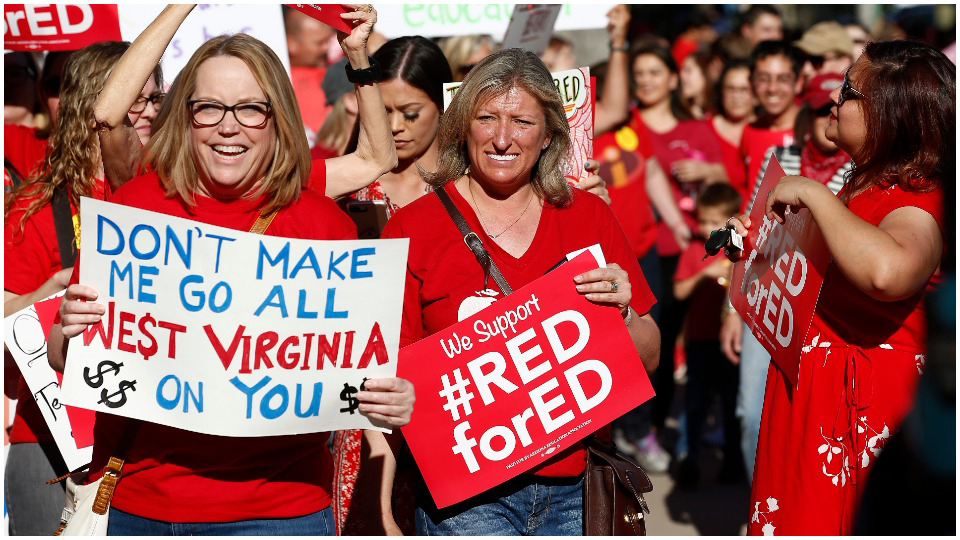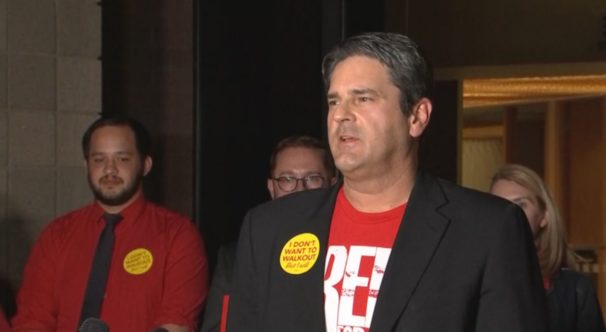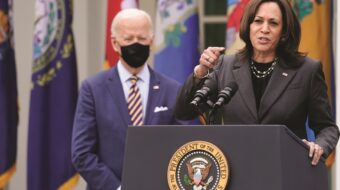
PHOENIX—Pushed to anger by a decade of spending declines and a state school money offer both inadequate and unfunded, Arizona teachers and school support staffers voted by 78 percent-22 percent to strike statewide on April 26.
At least 57,000 educators and staffers cast paper ballots in the three days of statewide voting, Arizona Education Association President Joe Thomas announced just after 9 pm Pacific time on April 19.
“Arizona educators have delivered a strong message,” said Thomas, a government teacher at Skyline High School in Mesa. “They overwhelmingly support walking out. This is undeniably a mandate for education.”
The Arizona vote is the latest grassroots uprising of teachers, parents, and their allies in GOP-run red states, where governors and lawmakers have shorted education and other services in favor of tax cuts for the rich and corporations.
It follows similar strike-won successes, with huge public support, in West Virginia and Oklahoma, plus a sick-out in Kentucky. That forced that state’ GOP governor and legislature to reverse course on school spending and teacher pension cuts.
In the other two states, teachers won raises, more money to repair schools and buy new books and raises for support staffers—and, in West Virginia, for other state government workers, too.
The Arizona strike will occur after teachers and staffers spend the first three days of the week demonstrating solidarity with more “walk-ins” at schools around the state. They’ll also meet school administrators to coordinate orderly action—and get support.
The first set of walk-ins saw more than 100,000 teachers, staffers, and parents at 110 school districts, all wearing “#RedforEd” T-shirts, lock arms and march into the schools in solidarity three minutes before opening bells rang.
The only way the strike would not occur, Thomas and the leaders of the citizens group Arizona Education United told a packed press conference outside the union headquarters at the time, would be if GOP Gov. Doug Ducey and the GOP-run legislature came to their senses and restored the $1 billion the state’s schools have lost in the last decade—and guarantee the funds will be there. “That’s what they were elected for,” he said.
And they can do that, said Thomas, by repealing past tax breaks for corporations and the rich and by other dedicated funding, rather than the jerry-built plan Ducey offered just before the vote. Ducey offered a 10 percent raise, for teachers only, next year and promised 10 percent more by 2020. But his funding was dubious.
Per pupil spending in Arizona has declined for years, Thomas said in an interview with People’s World. And National Education Association data show Arizona is dead last—51st—among all states and D.C. in median teacher pay, at $47,218 a year. It’s also #4 in crowded classrooms. Thomas said classes with students numbering in the mid-30s and up to 40 are common.
“I’m tired of meeting ex-Arizona teachers who fled to other states,” Thomas told the crowd in Phoenix.
In our interview, Thomas said teachers are angry enough—and have drawn huge public support—to walk. That’s even though a 46-year-old ruling by the state attorney general’s office says the teachers, in a right-to-work state, can’t legally strike.
“I think we’re strong and ready to go,” he said. “We have school districts that are absolutely ready” to strike, including in Mesa, the state’s largest, the Phoenix high-school-only district, and Tucson.
AEA didn’t organize the first protests, he explained. A seven-week-old grassroots citizens group, Arizona Education United, which now has 45,000 members, did. It was formed over social media. Now, AEA is an enthusiastic partner with the citizens group.
The first “walk-in” was the latest in a series of actions that saw 6,000 teachers invade the state capitol building in Phoenix, demanding money to help pay for quality education for kids. Besides 20 percent raises for themselves and support staffers, they want up-to-date textbooks and decent buildings.
Ducey offer to teachers, hastily put together, wasn’t enough. His plan was funded by slashing money for educating the disabled and for the arts, taking cash from the state’s Medicaid fund, and other one-time methods. Teachers and their allies realized quickly it didn’t add up, Thomas said in the interview. They want Arizona to reverse its 23 percent cut in school spending since 2008, with permanent measures.

The situation is so bad that 150,000 Arizona students—one in every seven—sit in classrooms being taught by long-term substitutes or short-termers who could have as little qualifications as a high school diploma or a GED, according to Thomas.
“We need competitive salaries” for the support staff also, Thomas explains. “If you’re the librarian, you don’t get the raise” in the governor’s plan. “And if you’re a classified employee”— a category of support staffers—“you’re not even thought of.
“So the teachers are really pissed. There’s the cafeteria worker, the bus driver, the counselor. They’re all doing their jobs so I can teach social studies. And I’m going to get a raise and they aren’t? Hell, no.”












Comments